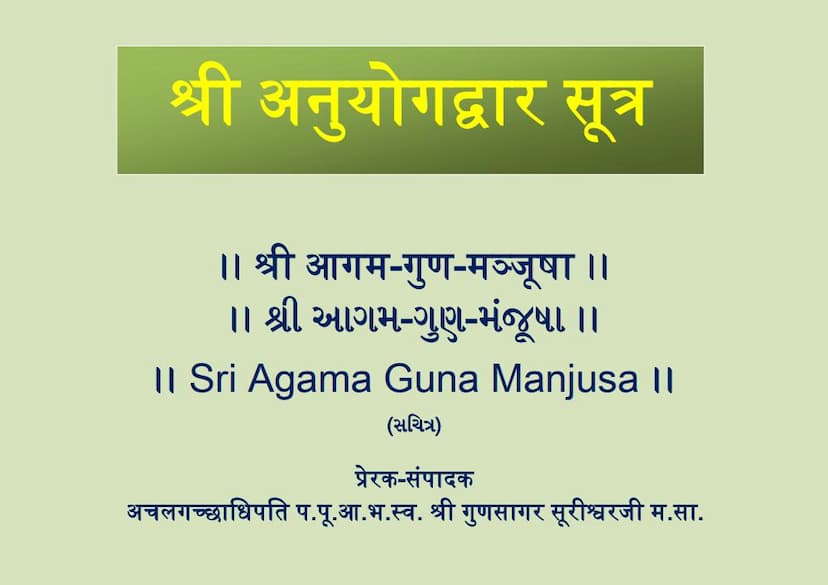Agam 45 Chulika 02 Anuyogdwar Sutra Shwetambar Agam Guna Manjusha
Added to library: September 1, 2025

Summary
This document, titled "Sri Agama Guna Manjusha" (Agam 45 Chulika 02 Anuyogdwar Sutra), is a Gujarati explanation and translation of the Jain scripture Anuyogdwar Sutra, authored by Gunsagarsuri and published by Jina Goyam Guna Sarvoday Trust Mumbai. It provides a concise overview of the 45 Agamas (Jain scriptures) and then delves into a detailed explanation of the Anuyogdwar Sutra itself.
Here's a summary of the key sections and their content:
1. Introduction to the 45 Agamas: The text begins by briefly introducing the 12 Anga Sutras, 12 Upanga Sutras, 10 Prakirna Sutras, 6 Cheda Sutras, and 2 Chulika Sutras, along with some other minor categories. For each scripture, it provides a concise description of its main themes, number of chapters/sections, and approximate number of verses. The focus is on highlighting the essence and scope of each text within the broader Jain canon.
- Anga Sutras (11 texts): Covers scriptures like Acārāṅga Sūtra (conduct), Sūktāṅga Sūtra (philosophical viewpoints), Sthānāṅga Sūtra (mathematical and philosophical classifications), Samavāyāṅga Sūtra (collections and classifications), Vyākhyāprajñapti Sūtra (Bhagavati Sūtra - the largest, covering various topics), Jñātādharmakathāṅga Sūtra (religious narratives), Upāsakadashāṅga Sūtra (householder's vows and lives), Antakṛdashaṁga Sūtra (lives of liberated souls), Anuttaropapātika Daśaṁga Sūtra (lives of those attaining higher realms), Praśnavyākaraṇa Sūtra (questions and answers on conduct), and Vipāka Sūtra (fruits of karma).
- Upanga Sutras (12 texts): Includes scriptures like Oupapātika Sūtra (description of cities and austerities), Rāyapasenīya Sūtra (king Pradesi's story and idol worship), Jivābhigama Sūtra (analysis of self and non-self), Prajñāpanā Sūtra (description of 36 topics), Sūrya Prajñapti Sūtra and Chandra Prajñapti Sūtra (celestial movements), Jambūdvīpa Prajñapti Sūtra (description of the Jambu continent), and the Nirayāvalī Pacaka (Nirayāvalī, Kalpāvatamsaka, Pupphiya, Pupphacūlikā, and Vṛṣṇidaśā Sūtras - stories of hellish beings, princes, etc.).
- Prakirna Sutras (10 texts): Mentions scriptures like Chaturśaraṇa Prakirṇa Sūtra (four refuges), Ātura Pratyākhyāna Prakirṇa Sūtra (final practices), Bhakta Parijñā Prakirṇa Sūtra (types of death), Sansthāraka Prakirṇa Sūtra (glory of Santhara), Tandula Vaichārika Prakirṇa Sūtra (dietary habits over time), Chandāvijaya Prakirṇa Sūtra (death rituals), Devendra-stava Prakirṇa Sūtra (hymns of Indra), Maraṇa Samādhi Prakirṇa Sūtra (final practices), Mahāpratyākhyāna Prakirṇa Sūtra (monk's final practices), and Gaṇividyā Prakirṇa Sūtra (astrology).
- Cheda Sutras (6 texts): Includes Nishihta Sūtra, Mahānishihta Sūtra, Vyavahāra Sūtra, Jītakalpa Sūtra, Pañcakalpa Sūtra, and Daśaśruta Skandha Sūtra, dealing with serious discussions on rules, exceptions, and penance, meant for advanced monks.
- Mala Sutras (4 texts): Includes Āvaśyaka Sūtra (daily obligatory duties), Daśavaikālika Sūtra (conduct for monks and nuns), Uttarādhyayana Sūtra (last sermons of Lord Mahāvīra), and AnuYoga Dvāra Sūtra (explained in detail below).
- Chūlikā Sutras (2 texts): Nandi Sūtra (hymns, lists of Tirthankaras and Gaṇadharas, types of knowledge) and AnuYoga Dvāra Sūtra.
2. Detailed Explanation of Anuyoga Dvāra Sūtra: The Anuyoga Dvāra Sūtra is presented as the "key to all Agamas." It teaches the path of spiritual practice through a combination of firm resolve (Nishchaya) and worldly engagements (Vyavahāra). The Anuyoga (explanation) has four "doors" or aspects: 1. Utkrama (Upakrama): Beginning or cause. 2. Nikṣepa (Niskṣepa): Classification or laying down. 3. Anugama: Following or consequence. 4. Naya: Viewpoint or logic.
The text then proceeds to systematically explain these aspects as they apply to the Anuyoga Dvāra Sūtra itself and its constituent parts, such as:
- Āvaśyaka: It is considered essential for all four groups (monks, nuns, laymen, laywomen) and includes six obligatory duties: Sāmāyika (meditation), Chaturviṁśatistava (praise of 24 Tirthankaras), Vandana (obeisance), Pratikramaṇa (repentance), Kāyotsarga (body-stillness), and Pañcākhyāna (renunciation).
- Suya (Shruta - knowledge): Discusses different classifications and aspects of scriptural knowledge.
- Skandha: Explains the concept of sections or parts within scriptures.
- Varttavyatā (Speech/Expression): Discusses different ways of speaking and expressing.
- Arthādhikāra (Meaning/Essence): Focuses on the underlying meanings and objectives.
- Samoārya (Co-existence/Interaction): Explores how different elements interact or co-exist.
- Naya (Viewpoints): Delves into various philosophical standpoints and their application, particularly the Niegama, Sangraha, Vyavahāra, Ṛjūtra, Shabda, Samabhirūḍha, and Evabhūta Nayās.
The document is highly technical, using precise Jain terminology to analyze the structure, classification, and philosophical implications of scriptural knowledge and practice. It follows a systematic breakdown of concepts, demonstrating the rigorous analytical approach within Jain philosophy.
In essence, this text serves as a guide to understanding the foundational scriptures of Jainism, with a particular emphasis on the Anuyoga Dvāra Sūtra, which is presented as a critical tool for comprehending the entirety of Jain scripture and practice.